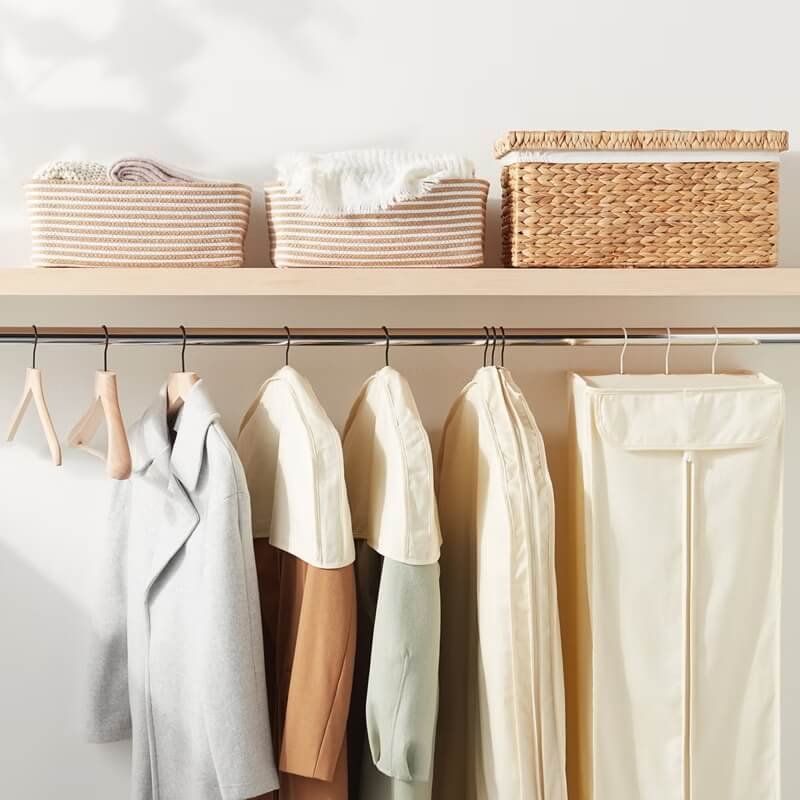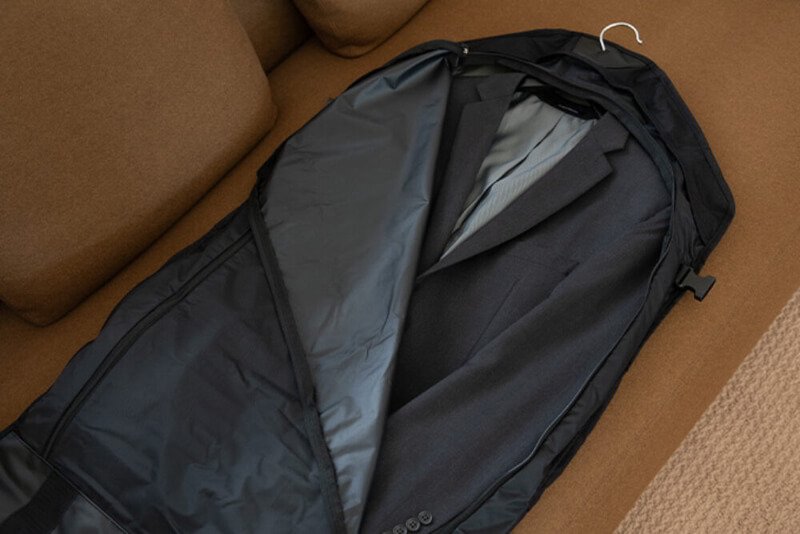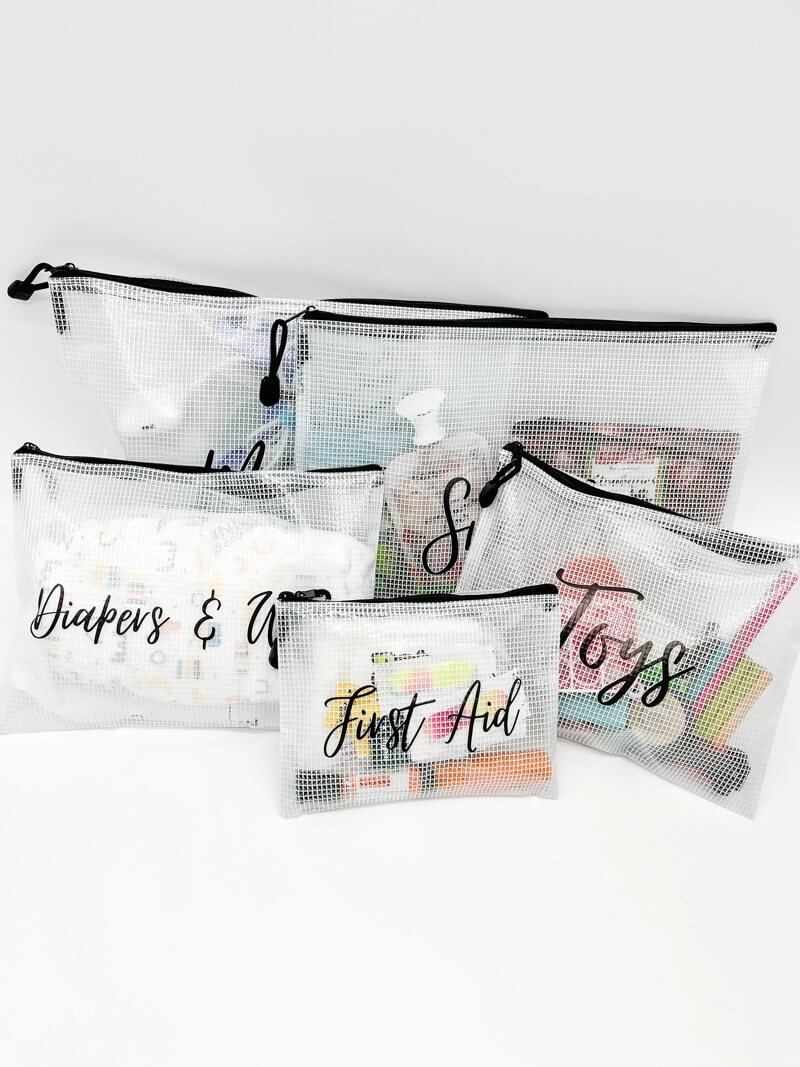Storing Clothes in Zipper Bags: A Complete Guide
Are your closets overflowing? Are you struggling to find space for out-of-season clothes? Or maybe you’re a frequent traveler looking for efficient packing solutions? Storing clothes properly is essential for keeping them in good condition, but many people are unsure about the best methods. Improper storage can lead to damage from dust, moisture, pests, and wrinkles, ruining your favorite garments and wasting money.
This comprehensive guide explores the versatile world of zipper bags for clothes storage. You’ll learn about the different types of bags available, the advantages and disadvantages of using them, and step-by-step instructions for storing your clothes like a pro. Discover how to protect your clothing investment, maximize space, and create an organized wardrobe, whether you’re storing items at home or packing for a trip.
1. Zipper bags – a versatile storage solution for clothes
Zipper bags have become a popular and practical solution for storing clothes. They offer a convenient, relatively inexpensive, and effective way to organize your wardrobe, protect your garments from damage, and save space.
Whether you’re looking to tidy up your closet, store seasonal clothing, pack efficiently for travel, or safeguard delicate items, zipper bags can be a valuable tool. This guide provides everything you need to know about using zipper bags effectively for clothes storage, garment storage, closet organization, and travel packing.

2. Benefits of using zipper bags for clothes storage
Zipper bags offer a range of advantages for storing clothes.
2.1 Protection from the elements: Dust, moisture, and pests
Zipper bags create a protective barrier around your clothes, shielding them from dust, moisture, and pests.
- Dust: Dust can settle on clothes, dulling colors and making them look dingy over time. Zipper bags prevent dust accumulation.
- Moisture: Moisture is a major enemy of stored clothing. It can lead to mildew, mold growth, and unpleasant musty odors. Zipper bags, especially those made of waterproof materials, help keep clothes dry.
- Pests: Moths, silverfish, and other insects can cause significant damage to clothing, particularly natural fibers like wool and silk. Zipper bags provide a physical barrier against these pests.
- Helpful tip: Zipper bags are especially important for protecting clothes made from natural fibers.
2.2 Organization and visibility: See what you’ve got at a glance
Zipper bags are excellent for organizing clothes. You can group items:
- By type: Sweaters in one bag, shirts in another, etc.
- By season: Winter clothes in one set of bags, summer clothes in another.
- By outfit: For travel packing, create complete outfits in individual bags.
Transparent bags offer a significant advantage: you can easily see the contents without having to open the bag. This saves time and effort when you’re looking for a specific item. It helps with closet organization and locating your clothes in seasonal storage.
Helpful tip: Using clear zipper bags is like having X-ray vision for your closet!
2.3 Space-saving: Compressing for efficient storage
Zipper bags can help you save valuable storage space. By squeezing out excess air, you can reduce the volume of bulky items.
- Vacuum storage bags: These bags are designed to be used with a vacuum cleaner to remove all the air, significantly compressing the contents.
- Regular zipper bags: Even without vacuum sealing, simply pressing out the air from a regular zipper bag before sealing it can make a noticeable difference.
This is particularly useful for storing bulky items like sweaters, winter coats, blankets, and pillows. It helps to maximize closet space.
Helpful tip: If you’re short on storage space, vacuum storage bags are a game-changer.
2.4 Other benefits
- Easy-to-use: Zipper bags are very user friendly.
- Can make storing and transporting goods easier and faster.
- Useful for arranging and carrying clothes when traveling.
- Reusable: Zipper bags are reusable.
3. Potential drawbacks and considerations: When zipper bags aren’t ideal
While zipper bags offer numerous benefits, they are not a perfect solution for all clothing storage situations.
3.1 Not a universal solution: Fabric breathability and long-term storage
Zipper bags, particularly those made of plastic, can restrict airflow. While this is great for protection, some fabrics need to “breathe,” especially during long-term storage.
- Natural fibers: Leather, fur, suede, and heavily embellished garments are best stored in breathable containers.
- Airtight plastic bags: Storing in plastic bag can trap moisture, leading to mildew, mold, discoloration, or damage to the material.
For these items, breathable garment bags (made of cotton or canvas) are a better choice.

3.2 Durability and longevity: Choosing the right bag for the job
The durability and longevity of zipper bags vary significantly.
- Cheap, thin bags: Can tear or puncture easily, especially with repeated use or if overfilled.
- Heavier-duty bags: Made with thicker plastic and stronger zippers, are a better investment for long-term storage and for protecting valuable items. Even good-quality bags can degrade over time, especially with extreme temperatures or sunlight. Consider the bag quality, plastic thickness, and zipper quality.
3.3 Sustainability
Consider environment impacts when choosing the materials for zipper bags.
4. Types of zipper bags for clothes storage: Choosing the right option
Zipper bags for clothes storage come in a variety of types, each with its own features and best uses.
4.1 Standard zipper bags (polyethylene)
These are the most common type of zipper bag.
- Description: Clear, polyethylene (PE) bags with a zip-seal closure (often called “slider” bags).
- Availability: Readily available in various sizes, from small sandwich bags to extra-large jumbo bags.
- Cost: Relatively inexpensive.
- Uses: Suitable for general storage, organizing drawers and shelves, packing toiletries for travel, and storing out-of-season clothing.
4.2 Vacuum storage bags (compression bags): Maximizing space
These bags are designed to significantly reduce the volume of stored items.
- Description: Clothes are placed inside the bag, and a vacuum cleaner hose is attached to a valve to remove the air. This compresses the contents, creating a much smaller, flatter package.
- Benefits: Excellent for saving space, especially with bulky items.
- Drawbacks: Can cause wrinkles in some fabrics. Not suitable for all materials (see “Potential Drawbacks” section).
- Helpful tip: While these bags are excellent for saving space, be aware of the downside: they can cause significant wrinkles.
4.3 Heavy-duty zipper bags: For added durability and protection
These bags are made from thicker, more durable plastic.
- Description: Specifically designed for long-term storage or for protecting heavier or more valuable items. Often feature reinforced zippers and stronger seams.
- Benefits: Less prone to tearing or puncturing than standard zipper bags. Offer greater protection for valuable or delicate items.
- Uses: Ideal for storing heavier clothing items, items with sharp edges, or anything that needs extra protection during storage or transport.
4.4 Specialty zipper bags: Tailored solutions
- Moth-proof bags: Designed to protect against moths and other insects. May have tighter seals, be made of thicker material, or be treated with moth repellents.
- Garment bags with zippers: Full-length garment bags with zippers offer excellent protection for hanging clothes (suits, dresses, coats), and some are made from breathable materials.

5. Step-by-step guide: Storing clothes in zipper bags like a pro
Follow these steps for optimal results when storing clothes in zipper bags:
5.1 Preparing your clothes: Clean and dry is non-negotiable
This is arguably the most important step. Never store dirty or damp clothes in a zipper bag (or any storage container)!
- Clean: Wash or dry-clean all items according to their care labels before storing them. This removes dirt, stains, body oils, and food residue, all of which can attract pests, cause odors, and damage fabrics over time.
- Dry: Ensure clothes are completely dry before placing them in zipper bags. Even a small amount of moisture can lead to mildew and mold growth, especially in an airtight environment.
5.2 Folding or rolling: Maximizing space and minimizing wrinkles
Properly folding or rolling your clothes before placing them in zipper bags helps:
- Maximize space: You’ll be able to fit more items in each bag.
- Minimize wrinkles: Careful folding or rolling can prevent sharp creases.
- Keep clothes organized: Makes it easier to find what you need later.
Techniques:
- Rolling: Rolling is often the best method for saving space and preventing wrinkles, especially for items that aren’t prone to wrinkling (like knitwear, t-shirts, jeans). Roll items tightly, but not so tightly that you create creases.
- Folding: For items that wrinkle easily (like dress shirts, blouses, and linen garments), careful folding is usually better. Use a folding board for consistent results, or learn techniques like the KonMari method.
5.3 Choosing the right size bag: Avoid overfilling and stressing the zipper
Select a zipper bag that’s appropriately sized for the items you’re storing.
- Too small: Forcing items into a bag that’s too small can damage the clothes, stress the zipper, and make the bag more likely to tear.
- Too large: A bag that’s too large wastes space and allows the items to shift around excessively.
Choose a bag that allows the items to fit comfortably without being crammed, but also doesn’t have a lot of empty space.
5.4 Sealing the bag: Ensuring an airtight closure for maximum protection
Properly sealing the zipper bag is crucial for maximizing its protective benefits.
- Zip-seal (slider bags): Press firmly along the entire length of the zipper, making sure it’s completely closed. Run your fingers along the seal multiple times to ensure there are no gaps.
- Vacuum valve (vacuum storage bags): Follow the manufacturer’s instructions carefully for using a vacuum cleaner to remove air. Ensure the valve is properly sealed after air removal.
An airtight seal (or as close to airtight as possible) is essential for protecting your clothes from dust, moisture, and pests.
5.5 Squeeze the air
Remove excess air from regular zipper bags before sealing them.
5.6 Labeling (optional but highly recommended): Easy identification later
Labeling your zipper bags with the contents and the date of storage is highly recommended, especially for long-term storage. This will save you a significant amount of time and effort when you need to retrieve specific items later. You won’t have to open multiple bags to find what you’re looking for.
Labeling options:
- Adhesive labels: Write directly on adhesive labels and stick them to the bags.
- Permanent marker: Write directly on the bag with a permanent marker (if the bag material allows).
- Reusable tags: Use reusable tags that you can tie or clip onto the bags.

6. Where to store zipper bags: Finding the ideal location
The storage location is just as important as the storage method.
6.1 Cool, dry, and dark: The ideal storage conditions
The best storage environment for clothes is cool, dry, and dark.
- Cool: Avoid extreme heat, which can damage fibers, fade colors, and accelerate the degradation of fabrics.
- Dry: Avoid high humidity and moisture, which can lead to mildew, mold growth, and musty odors.
- Dark: Avoid direct sunlight, which can fade colors and weaken fabrics, especially natural fibers.
6.2 Common storage options: Maximizing space and accessibility
Suitable storage locations include:
- Closets: On shelves, in drawers, or hanging (for garment bags with zippers).
- Under-bed storage containers: Zipper bags are ideal for fitting inside under-bed storage boxes.
- Shelves: In a linen closet, storage room, or other shelving unit.
- Drawers: For smaller items or folded clothes.
- Storage bins/totes: Stackable plastic bins (ensure they are stored in a cool, dry, dark place).
Avoid:
- Unfinished attics: Unless they are climate-controlled, attics often experience extreme temperature fluctuations.
- Unfinished basements: Unless they are climate-controlled, basements are often damp and prone to moisture problems.
- Garages: Unless climate-controlled, garages are subject to extreme temperature changes and may be exposed to pests.
7. Long-term storage: Extra precautions for preserving your clothes
For clothes stored in zipper bags for extended periods (several months or longer), take these extra precautions:
7.1 Consider adding desiccants: Combating moisture
Even in a relatively dry environment, some moisture can accumulate over time. To combat this, place desiccant packets (silica gel packets) inside the zipper bags, especially for long-term storage and in humid climates. Desiccants absorb excess moisture, helping to prevent mildew, mold, and musty odors. You can often find silica gel packets in new shoe boxes, with electronics, or you can purchase them separately.
7.2 Moth protection (for natural fibers): Preventing unpleasant surprises
Clothes made of wool, silk, cashmere, fur, or other natural fibers are susceptible to damage from clothes moths. Moth larvae feed on these fibers, creating holes and ruining garments. To prevent moth infestations:
Clean clothes: Always store clean clothes. Moths are attracted to food residue, sweat, and body oils.
Moth repellents: Use moth repellents inside the zipper bags. Options include:
- Cedar blocks, chips, or sachets: Cedar has a natural scent that repels moths. Cedar needs to be refreshed periodically (by lightly sanding the surface) or replaced to maintain its effectiveness.
- Lavender sachets: Lavender is another natural moth repellent with a pleasant scent.
- Mothballs: Mothballs are effective, but they have a strong, unpleasant odor that can be difficult to remove from clothes. Use them with caution and only in airtight containers.
7.3 Periodic checking: Monitoring your stored clothes
Even with the best precautions, it’s a good idea to check on your stored clothes periodically (every few months or at least once a year).
- Inspect for any signs of damage: Moisture, pests, discoloration, etc.
- Air out the clothes: Even if everything looks fine, airing out the clothes occasionally can help prevent musty odors.
- Refresh moth repellents: Replace or refresh cedar blocks/chips and lavender sachets.
- Replace desiccants: If the desiccant packets feel saturated, replace them with fresh ones.
8. Common mistakes to avoid when using zipper bags
To get the most out of your zipper bags and protect your clothes, avoid these common pitfalls:
- Storing damp or dirty clothes: This is the most critical mistake. Trapped moisture leads to mildew and mold, while dirt and oils attract pests and can cause permanent stains.
- Using airtight bags for sensitive fabrics: Natural fibers like leather, fur, and suede require airflow to prevent drying out, cracking, or discoloration. Use breathable garment bags for these items, not sealed plastic zipper bags.
- Overstuffing the bags: Cramming too many items into one bag can damage delicate clothing, cause deep-set wrinkles, and put stress on the zipper, leading to breakage.
- Forgetting to label: Storing bags without clear labels turns finding a specific item into a frustrating guessing game. Always label the contents and the date of storage.
- Relying on dry cleaner bags: The thin plastic bags from the dry cleaner are not meant for long-term storage. They offer no real protection from moisture or pests and can trap cleaning chemicals, which may damage fabric over time.

9. FAQs about storing clothes in zipper bags
9.1 Can I store leather or fur coats in zipper bags?
No, leather, fur, and suede items should not be stored in airtight plastic zipper bags for extended periods. These materials need to breathe. Storing them in plastic can trap moisture, leading to:
- Mildew and mold growth.
- Drying and cracking (leather).
- Damage to the fur.
Instead, use breathable garment bags made of cotton or canvas. These allow for air circulation while still protecting the garments from dust.
9.2 How long can I store clothes in zipper bags?
Clothes can be stored in zipper bags for many months, or even years, if the following conditions are met:
- The clothes are properly prepared: Cleaned and thoroughly dried before storage.
- The bags are of good quality: Made of durable plastic with a strong zipper.
- The storage location is suitable: Cool, dark, and dry.
- Appropriate precautions are taken: Desiccants for moisture control, moth repellents for natural fibers.
However, even with ideal conditions, it’s recommended to check on your stored clothes periodically (every few months or at least annually) to ensure they remain in good condition.
9.3 Will storing clothes in zipper bags prevent wrinkles?
Zipper bags can help minimize wrinkles, especially if clothes are folded or rolled neatly and not overpacked. However, some wrinkling may still occur, particularly with fabrics that are prone to creasing (like linen or rayon).
Vacuum sealing can sometimes increase wrinkles, especially in delicate fabrics. So, while vacuum bags are great for saving space, they’re not always the best choice for items you need to wear immediately upon unpacking.
9.4 Are zipper bags better than storage bins or boxes?
The best storage method depends on your specific needs. Zipper bags and storage bins/boxes each have pros and cons:
Zipper bags – pros:
- Visibility: Clear bags allow you to see the contents.
- Space-saving: Especially vacuum-sealed bags.
- Protection: Offer good protection from dust, moisture, and pests.
- Flexibility: Can conform to different shapes and sizes.
Zipper bags – cons:
- Not as crush-proof as rigid containers.
- Not ideal for all fabrics (breathability concerns).
Storage bins (rigid plastic containers) – pros:
- Crush-proof: Offer excellent protection for delicate items.
- Stackable: Efficient use of vertical space.
- Durable: Can last for many years.
Storage bins – cons:
- Less flexible: Not as adaptable to different shapes and sizes.
- Opaque: You can’t see the contents unless they’re labeled.
Cardboard boxes:
- Pros: Inexpensive.
- Cons: Offer no protection from insects or moisture.
The best choice depends on the items you’re storing, the available space, your budget, and your personal preferences. Often, a combination of different storage methods works best.
9.5 How do I get rid of musty smells from clothes that have been stored in zipper bags?
A musty smell usually indicates the presence of moisture and potentially mildew or mold.
- Remove the clothes from the bags: Immediately take the clothes out of the zipper bags.
- Air them out thoroughly: Hang the clothes outdoors in fresh air and sunlight, if possible. Sunlight can help kill mold and mildew spores.
- Wash the clothes: Wash the clothes according to their care labels, using a detergent that contains enzymes to help break down odors.
- Add a laundry booster: Consider adding a laundry booster like baking soda or white vinegar to the wash cycle to help neutralize odors. (Do not use both baking soda and vinegar together in the same wash.)
- Dry thoroughly: Make sure the clothes are completely dry before storing them again.
To prevent musty smells in the future:
- Ensure clothes are 100% dry before storing.
- Use desiccant packets inside the zipper bags to absorb excess moisture.
- Store the bags in a cool, dry place.
- Air out stored clothes periodically.
Read more:
Storing clothes in zipper bags is a versatile and effective way to protect garments from dust, moisture, pests, and wrinkles. It’s also a great way to organize your closet, pack for travel, and save space. By following the steps outlined in this guide – preparing your clothes properly, choosing the right type of bag, and storing them in a suitable location – you can extend the life of your clothing and keep it looking its best. Remember to consider fabric type, use desiccants and moth repellents when necessary, and periodically check on your stored items. Happy organizing!






















